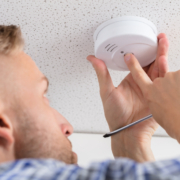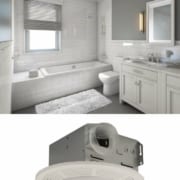Have you ever wondered why some bathrooms have fans in the ceiling? Bathroom exhaust fans are designed to remove the inevitable humidity created by running hot water at the sink and running the shower. Excess indoor humidity often times helps create an environment prone to indoor mold growth, which no homeowner wants to have to deal with.
There are a few different types of bathroom fans available, but we are only going to focus on two types in this post. Those types are ducted exhaust fans and ductless exhaust fans.
Ducted fans are far more prevalent in residential buildings and are my preferred design. Ducted fans should be installed so that the duct carries the humid air from the bathroom directly to the exterior of the home. This means it should not deliver the air to a crawlspace or to an attic space as this will create a humid environment that could cause paint to peel, wood to warp, and mold to grow.
The second type of bathroom fan that we’ll discuss is a ductless system. Ductless bathroom fans typically use a canister with charcoal in it to filter odors out of the air. Some companies also claim that they reduce the humidity in the room by soaking up moisture. Personally, I disagree with that method; there’s no place for the moisture to go after the charcoal absorbs it except back into the ambient air where it originally came from. If you are going to install a ductless fan, then make sure to install it in a half-bath where there isn’t a shower or a tub.
Thankfully bathroom exhaust fans don’t require a ton of maintenance. Every year or so get up there and clean all the dust and lint off the fan screens. A buildup of debris on the screen significantly increases the risk of a fire. The air that passes through the fan is also the air that cools the motor and electrical components in the fan.
Who knew bath fans were so important features of a home? Make sure you have the right type of fans in the right places and ducting properly and you’ll be in good shape.
Crosswind Home Inspection
Proudly serving Orange County and Los Angeles County, including Cerritos, Huntington Beach, Los Alamitos, Seal Beach, Westminster, Long Beach, Surfside, Sunset Beach, Irvine, Belmont Shores, Lakewood and beyond.
7:00 AM-7:00 PM


